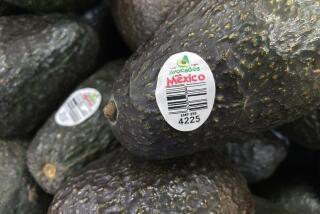Food Plant Inspections Decline
- Share via
The frequency of federal inspections of food processing plants--considered a crucial link in maintaining food safety and wholesomeness--declined by as much as 50% since 1989 despite the fact that the $600-billion industry has grown substantially during the same period, according to a recent General Accounting Office report. Among the most surprising details to emerge is that some food manufacturing facilities are being inspected only once every eight years.
The study was conducted by the GAO, the congressional watchdog agency, “in response,” the report said, “to continuing outbreaks of food poisoning.” The federal government spends about $1.2 billion on food safety efforts, up about 10% since 1989. However, staffing levels have remained the same, at about 17,000 employees, while responsibilities and workloads increased.
GAO’s findings come at the same time several consumer groups have charged that the federal government is, in essence, deregulating the food industry by reducing plant inspections and retreating from a front-line food safety role in many respects.
A new approach to inspection, entitled Hazard Analysis and Critical Control Points (HACCP), is expected to be announced shortly for meat and poultry. HACCP, characterized as a “significant shift” in federal policy, will further diminish the government’s presence in meat, poultry and seafood plants. Rather than looking at all phases of a plant’s operation, inspectors working under the HACCP plan will target only the most important points on the production line in terms of potential contamination hazards.
Under HACCP, federal inspectors will rely on a company’s record keeping to determine if a plant is in compliance with safety regulations. Plants with a history of problems will receive more scrutiny than those with a clean record.
“The government’s role [under HACCP] will shift from mainly conducting physical inspections to assessing each plant’s safety system [record keeping] and its effectiveness,” the GAO reported.
The Food and Drug Administration and the Food Safety and Inspection Service have decreased the frequency with which they visit food manufacturing facilities. The inspection service regulates the meat and poultry industries, and the FDA oversees dairy, seafood and most processed foods. The diminishing government role in food safety is particularly evident at the FDA: Plants that used to be inspected by agency officials once every three years are now visited only once every eight years.
“FDA’s inspection frequency continues to be constrained by resources,” according to the GAO report, which was an update of a comprehensive review of the subject in 1990. “The number of food plants inspected dropped from 6,368 in 1989 to 4,799 in 1994,” a decline of 25%.
FDA officials did not challenge the GAO figures.
FSIS has been similarly squeezed because a smaller force of inspectors is attempting to inspect a record number of food animal slaughters. For example, the number of chickens processed from 1989 to 1994 increased 28% to 7.2 billion birds annually. The number of hogs brought to market during the five-year period increased 10% to 90 million head. All other categories of food animals except for lamb also increased during the time studied.
The GAO concluded that the FDA’s and the inspection service’s “ability to inspect plants on the basis of the risk they pose is limited.”
A Washington-based advocacy group, the Government Accountability Project, recently released a report with similar findings.
“When inspectors can reach sometimes more than a dozen plants in a day, they can only skim the surface. Serious hazards are missed. Last year, the number of ‘Not Performed Tasks’ due to lack of [USDA inspectors] reached a record 1,074,091 up from 166,367 the previous year,” the group claimed, based on its review of government records and interviews with 45 USDA inspectors from throughout the country.
“The truth is that severe inspector shortages have resulted in millions of pounds of meat and poultry entering commerce without federal inspection in processing plants,” the group stated. “When inspectors are able to do their jobs, the system works in catching the worst abuses.”
More to Read
Inside the business of entertainment
The Wide Shot brings you news, analysis and insights on everything from streaming wars to production — and what it all means for the future.
You may occasionally receive promotional content from the Los Angeles Times.










